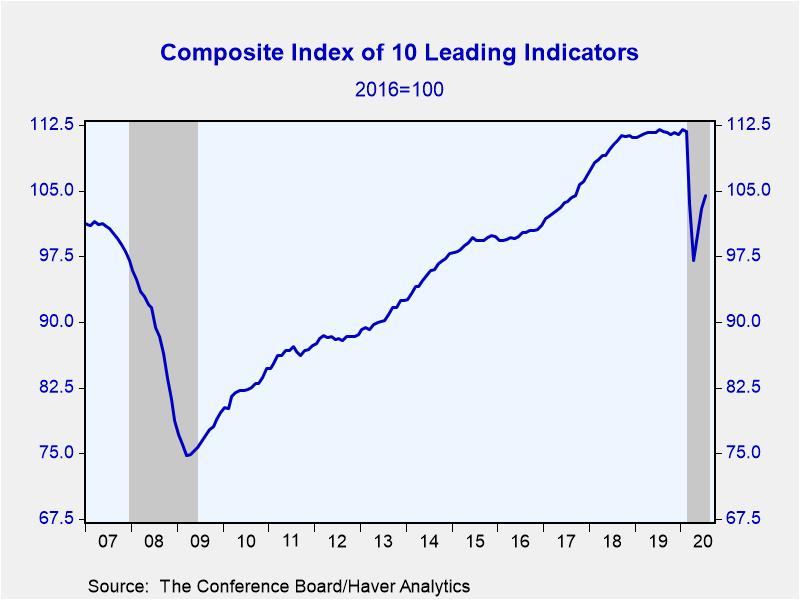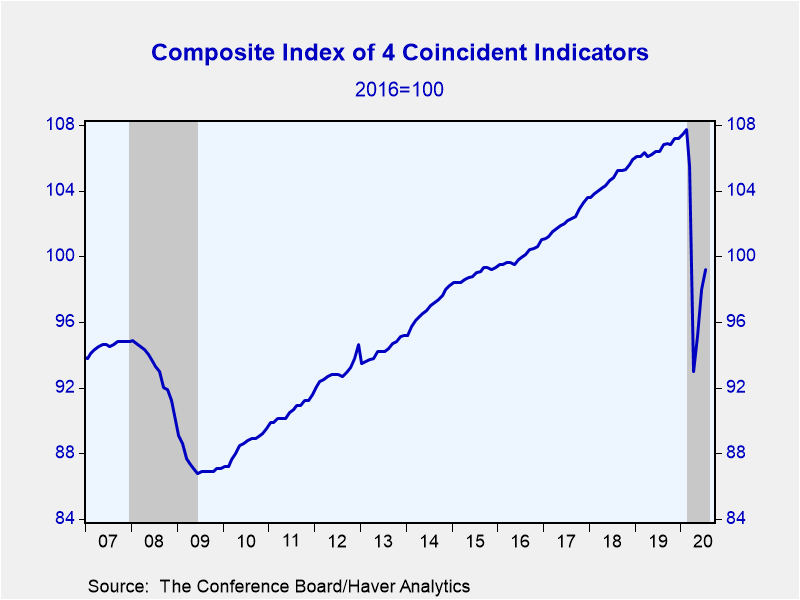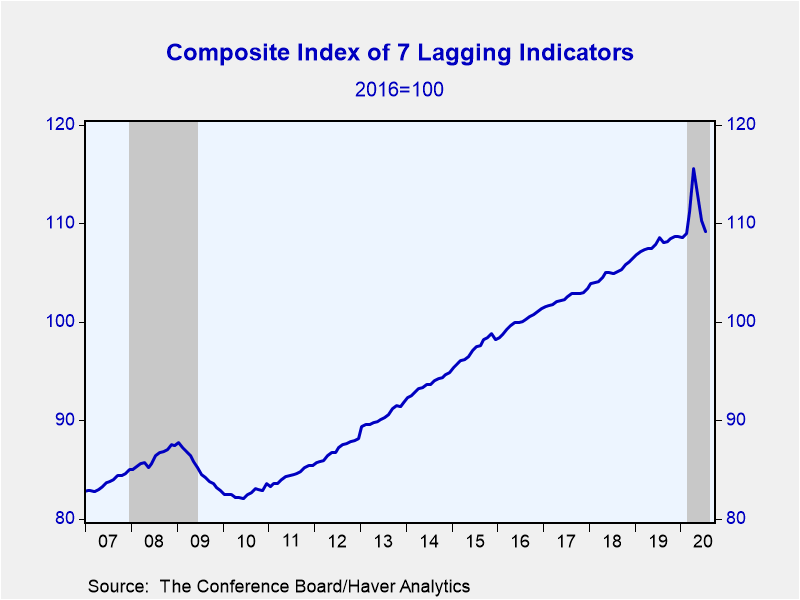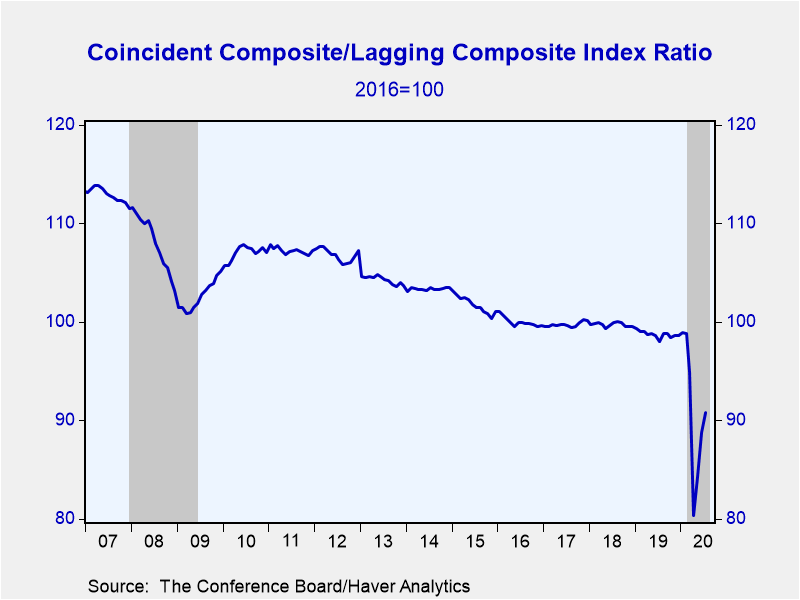 Global| Aug 20 2020
Global| Aug 20 2020U.S. Leading Indicators Continue to Increase in July
by:Tom Moeller
|in:Economy in Brief
Summary
• Component gains are somewhat mixed. • Coincident indicators rise further. • Lagging indicators indicate less economic stress. The Conference Board reported that its Composite Index of Leading Economic Indicators increased 1.4% [...]
• Component gains are somewhat mixed.
• Coincident indicators rise further.
• Lagging indicators indicate less economic stress.
The Conference Board reported that its Composite Index of Leading Economic Indicators increased 1.4% during July following a 3.0% June rise revised from 2.0%. A 1.0% gain had been expected in the Action Economics Forecast Survey. The series is comprised of 10 components which tend to precede changes in overall economic activity.
Last month's gain in the leading index again reflected mixed improvement amongst the component series. Six of the ten components rose and four fell. The largest positive contributions came from a longer factory sector workweek which added 0.6 percentage points to the index change, more building permits which added 0.5 percentage points and fewer initial unemployment insurance claims which added 0.4 points. Higher stock prices and a higher ISM new orders index also contributed positively. These gains were offset by declines in the consumer expectations for business/economic conditions index, the leading credit index and fewer orders for consumer goods & materials.
Three-month growth in the leading index surged to a record 34.2% (AR) in July, up versus a record rate of decline of 43.7% in April.
The Index of Coincident Economic Indicators increased 1.2% in July following a 2.9% June increase, revised from 2.5%. Each of the four component series increased including payroll employment which added 0.7 percentage points to the index rise and industrial production which added 0.4 percentage points. Personal income less transfer payments and manufacturing & trade sales added minimally to last month's increase.
Three-month growth in the coincident index also surged to 29.5% (AR) as it rebounded from a -25.5% rate in June.
The Index of Lagging Economic Indicators continued to indicate declining economic stress as it fell 1.0% (+0.6% y/y) after declining 2.3% in June, revised from -2.5%. Less stress included a fall in the average duration of unemployment which subtracted 0.5 percentage points. Fewer commercial & industrial loans outstanding also subtracted 0.5 percentage points while unit labor cost growth subtracted 0.3 percentage points. Working the other way, the consumer installment credit/personal income ratio and growth in the services CPI added marginally to the index change.
Three-month growth in the lagging index in July plunged to -20.4% (AR) from +28.4% three months earlier.
The ratio of coincident-to-lagging economic indicators is considered another leading indicator of economic activity. It rose sharply for a third consecutive month from its near-record low.
The Conference Board figures are available in Haver's BCI database; the components are available there, and most are also in USECON. The expectations are in the AS1REPNA database. Visit the Conference Board's site for coverage of leading indicator series from around the world.
The minutes to the latest FOMC meeting can be found here.
| Business Cycle Indicators (%) | Jul | Jun | May | Jul Y/Y | 2019 | 2018 | 2017 |
|---|---|---|---|---|---|---|---|
| Leading | 1.4 | 3.0 | 3.1 | -6.8 | 1.6 | 5.7 | 3.9 |
| Coincident | 1.2 | 2.9 | 2.4 | -6.8 | 1.8 | 2.5 | 2.2 |
| Lagging | -1.0 | -2.3 | -2.3 | 0.6 | 2.8 | 2.5 | 2.4 |
Tom Moeller
AuthorMore in Author Profile »Prior to joining Haver Analytics in 2000, Mr. Moeller worked as the Economist at Chancellor Capital Management from 1985 to 1999. There, he developed comprehensive economic forecasts and interpreted economic data for equity and fixed income portfolio managers. Also at Chancellor, Mr. Moeller worked as an equity analyst and was responsible for researching and rating companies in the economically sensitive automobile and housing industries for investment in Chancellor’s equity portfolio. Prior to joining Chancellor, Mr. Moeller was an Economist at Citibank from 1979 to 1984. He also analyzed pricing behavior in the metals industry for the Council on Wage and Price Stability in Washington, D.C. In 1999, Mr. Moeller received the award for most accurate forecast from the Forecasters' Club of New York. From 1990 to 1992 he was President of the New York Association for Business Economists. Mr. Moeller earned an M.B.A. in Finance from Fordham University, where he graduated in 1987. He holds a Bachelor of Arts in Economics from George Washington University.










